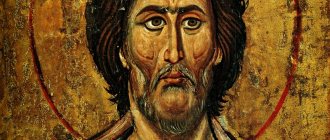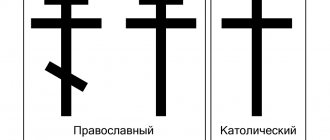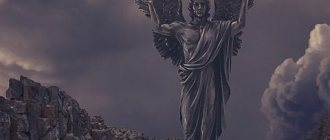The Exodus of the Jews from Egypt is a biblical legend described in the Old Testament in the book of Exodus. The Exodus of the Jews is one of the most widely covered events in the Bible, which, however, does not lead to a unanimous opinion among Bible scholars about the reliability of these events.
The tradition of Moses leading the Jews out of Egypt has had a particular influence on the theology of certain movements in Christianity. For example, Protestants, fleeing persecution, often sought moral support in tradition; Catholics used the exodus of the Jews as a prototype of the search for political freedom.
Background to the exodus of the Jews from Egypt.
The family of Israel moved to Egypt because of the famine that reigned in Canaan. According to the Old Testament, the Jews lived in Egypt for over 400 years. During this time, their numbers increased significantly. The book of Exodus says:
...the children of Israel became fruitful and multiplied, and increased, and became exceedingly strong, and the land was filled with them. (Book of Exodus, chapter 1)
A new pharaoh ascended the throne, who feared that the people of Israel might eventually conquer the local population, and therefore sent the Jews to grueling labor to reduce their numbers. The next measure Pharaoh took was to kill the Hebrew boys. He ordered the midwives to kill every boy born into a Jewish family, but the women were God-fearing and did not carry out the cruel order of Pharaoh. Then the pharaoh simply ordered the boys to be drowned.
At this time, Moses was born, who was destined to lead the people of Israel from Egyptian captivity. Moses' mother, in order to save her son, put him in a basket and sent him down the river. Moses was found by Pharaoh's daughter and taken to the palace.
Moses grew up in the house of Pharaoh. One day he saw an Egyptian overseer treating one of the Jews harshly at hard labor. Moses stood up for the poor fellow and killed the overseer. Pharaoh ordered Moses to be killed for this act, but he managed to escape to the land of Midian, where he married the daughter of a local priest.
Some time later, the Lord appeared to Moses in a burning bush and ordered him to return to Egypt and lead the Jews from Egyptian captivity to the Promised Land. Moses returns to Egypt and appears before Pharaoh, demanding the release of the people of Israel. Pharaoh refuses and then God sends the Ten Plagues of Egypt to the country. You can read more about the 10 plagues in this article or directly in the chapters of the Bible (Book of Exodus, chapters 7 - 12).
The Israelites settled in Egypt due to famine
The biblical story of the exodus of the Jewish people from Egypt begins with the fact that the shepherd family of Jacob-Israel, fleeing the famine that struck Canaan, left this land and moved to live in fertile Egypt.
The fugitives settled here in the land of Goshen (now Tumilath) (Gen. 46:6). The son of Jacob, Joseph the Beautiful, thanks to his abilities, became an adviser to Pharaoh and became related to representatives of the local aristocracy.
"Israel in Egypt". Painting by Edward Poynter 1867. In order to reduce the number of Israelis living in Egypt, the new pharaoh ordered them to be sent to hard work. Photo: ja-tora.com
The Bible says that the Israelites lived in Egypt for 430 years (Exodus 12:40). In addition, the Holy Scriptures also tell us that during this time the number of the Jewish people in Egypt increased greatly (Ex. 12:40).
As a result, there were more Israelis in Egypt than there were Egyptians themselves. After the death of the old pharaoh and the ascension to the throne of a new one who did not know Joseph, persecution began against them.
To reduce the number of Israelites in Egypt, Pharaoh ordered the killing of their firstborn sons.
The fact is that the new ruler was afraid of the possibility of a military clash and sent the sons of Israel to hard work, trying in this way to reduce their numbers (Ex. 1:10-11).
It was to no avail. To correct the current situation, he ordered the killing of all babies born to the Israelites (Ex. 1.15-22). During this period, the prophet Moses was born. It was Moses who led the Jews out of Egypt.
Moses being lowered by his mother onto the waters of the Nile. Tyranov Alexey Vasilievich, 1808-1859. In order to save baby Moses from being killed by the Egyptians on the orders of Pharaoh, his mother Jochebed floated him in a tarred basket along the waters of the Nile. Photo: ippo.ru
In order to save the baby from murder, his mother Jochebed put her three-month-old son in a tarred basket and floated him along the waters of the Nile under the supervision of her daughter. Pharaoh's daughter went to the river to swim, saw a floating basket and took it to her house.
Jochebed later entered her service and became the nurse of her own son. Moses grew up and was brought up at the court of Pharaoh, but one day he went out to the Israelites and killed the Egyptian overseer, who was cruelly punishing his fellow tribesman.
Moses
As a result, Moses had to flee Egypt and settle in the land of the Midianites.
Crossing the Red Sea
After this event, the Jews left Egypt. Apparently there were at least 600 thousand men, and apparently at least one and a half million in total. Pharaoh chased after the Jews, but the Lord helped his people and the waters of the sea parted, allowing Moses and His people to pass, but when the people of Israel passed, the waters closed again and led to the death of Pharaoh’s army, which was following on the heels of the Jews.
… And the Lord delivered Israel that day from the hand of the Egyptians, and the [sons of] Israel saw the Egyptians dead on the seashore. (Exodus chapter 14)
After crossing the Red Sea, the Israelites believed even more in the Lord and in his prophet Moses. They sang a song of praise to the Lord - Exodus chapter 15.
God appeared to Moses and commanded him to lead the Israelites out of slavery
The legend about the exodus of the Jews from Egypt says that while living among the Midianites, Moses married the daughter of a Midian priest and tended his father-in-law's cattle. One day he went to graze a flock near a mountain, and the Lord appeared to him in a burning but unburnt bush (burning bush).
God commanded Moses to return to Egypt and lead the Israelites out of slavery to resettle them in Canaan (the promised land), which was promised to their forefathers.
Burning bush. Bourdon, Sebastian. 1616 - 1671. When the prophet Moses turned 80 years old, the Lord appeared to him in a burning and unburnt bush (burning bush) and commanded him to return to Israel in order to lead the Jews out of it
This happened when Moses turned 80 years old. Returning to Egypt, the prophet demanded that Pharaoh release the Israelites from Egypt. The ruler refused him this, then God sent ten disasters or the Ten Plagues of Egypt to Egypt.
The first nine plagues did not have the desired effect on Pharaoh, but when after the tenth all the firstborn children of the Egyptians and the firstborn cattle died, Pharaoh allowed the Israelites to leave Egypt.
600 thousand
so many Jewish families, according to the Bible, left Egypt
The Holy Scriptures say that all ten plagues did not affect the Israelites, and during the last plague, the houses of the Jews were marked with the blood of a sacrificial lamb, so the angel of death passed them by.
Before fleeing, the Israelites collected valuables from the Egyptians. After this they left Egypt. The Bible says that 600,000 men and their families left the country.
The passage of the Jews through the Red Sea. I.K. Aivazovsky. 1891 The Bible says that when the Israelites needed to cross the Red Sea, it parted, through the prayer of the prophet Moses. After all the Israelites had passed, it swallowed up Pharaoh's army. Photo: upload.wikimedia.org
Having learned about the flight of the Jews from the country, Pharaoh changed his mind, gathered an army and, at its head, rushed in pursuit of the Israelis, hoping to enslave them again. Pharaoh's army overtook the Jews at the Red (Red) Sea (Hebrew: Yam Suf - “Sea of Reeds”).
The Holy Scripture says that by the will of God the waters of the sea parted, and the Israelites walked along the bottom, after which the waters closed, destroying the army of the Egyptians who tried to pursue them. (Ex. 14:28).
The wanderings of the Jews in the desert under the leadership of Moses.
Three months after the exodus from Egypt, Moses led the Jews to Mount Sinai. Here God's chosen people witnessed the appearance of the Lord. Here on Mount Sinai, God renegotiated the Covenant with His people and gave them the 10 Commandments and a large number of laws described in chapters 21 - 24 of the Book of Exodus. These laws were intended to regulate the everyday relations of Jews.
The Jews remained at Mount Sinai for a year. During this time, a camp temple (tabernacle) was built here, and priests from the Levites were appointed. Aaron became the high priest. Here was the first census of Jews, according to which among them there were more than 603 thousand healthy men who were capable of fighting.
The meaning of the parting of the Red Sea [↑]
What happened? Recent slaves are attacked by the Pharaoh's army. 600 iron chariot tanks act against people on foot with children in their arms. The Jews are in despair; their hearts turn to G‑d. And G-d miraculously saves his people, destroying the strongest army of that time.
In honor of this miraculous deliverance, which became a symbol of our faith in G-d, a separate holiday was established - the Seventh Day of Passover. This is a celebration of the birth from yesterday’s slave of a new free person who fully trusts in Divine Providence
.
And in all generations, when such selflessness and dedication are required from a Jew, we compare ourselves with Nachshon the son of Abminadab, who was the first to enter the water and moved forward until the water reached his very nose - Nachshon, who with his act caused the sea to part. Complete trust in G-d works miracles!
The Exodus of the Jews from Egypt - the camps of the Exodus.
It is known that the exodus of Jews from Egypt lasted 40 long years. The reason for this was that the people did not fully believe in the power of the Lord. When, having left Mount Sinai, the people of Israel crossed the Paran desert and approached the border of Hanaan, the Jews doubted that the Lord would help them defeat the Canaanites. For this, God condemned them to a forty-year wandering in the desert, during which everyone who was in captivity in Egypt died. When the Jews came to the Jordan, it was already a new generation.
The Bible describes 42 locations that were visited by the Jews during the exodus from Egyptian captivity under the leadership of Moses. The camps of the children of Israel are described in chapter 33 of the book of Numbers. There is also a lot of data in the book of Exodus and Deuteronomy.
If you believe the documentary hypothesis, the list of places visited during the exodus of the Jews from Egypt was not included in the original text of the Pentateuch and was added later.
The path of the Jews was not easy, but the Lord helped them not to die of hunger and thirst, sending them manna from heaven.
Ten wonders of Yam Suf [↑]
According to the Midrash, when the Jews crossed the Yam Suf
, The Almighty performed ten different miracles for them:
1. Water separation.
2. A protective covering, like a roof, was created over the heads of the Jews.
3. The waters were divided into twelve separate passages (one passage for each tribe).
4. The ground under the feet of the children of Israel was completely dry.
5. Under the feet of the Egyptians the earth was like clay. This was retribution, measure for measure, for the Egyptians who enslaved the Jews and forced them to work clay.
6. The waters became hard as rocks, wounding the Egyptians who were pursuing the children of Israel.
7. Solidified water formed walls decorated with mosaics.
8. The walls, formed from solidified water, were transparent, which allowed each tribe to see the others walking (this gave them a sense of confidence and security).
9. If a Jew, crossing Yam Suf
, felt thirsty, then he just had to stretch out his hand, and the wall would melt, giving excellent water to drink.
10. As soon as the Jew quenched his thirst, the wall became solid again.
Map of the Exodus of the Jews from Egypt.
Despite some disagreement between theologians and historians, today there are approximate maps of the exodus. Moreover, numerous studies are still ongoing in which scientists, interpreting the text of the Bible, are trying to reconstruct the route along which Moses led the Jews out of Egypt.
Forty years after leaving Egypt, the Israelites circled Moab, defeated the Amorites and reached the banks of the Jordan River near Mount Nebo. Here Moses died, appointing Joshua as his successor.
Ten Plagues That Were Inflicted on the Egyptians [↑]
The Midrash lists ten plagues that were inflicted on the Egyptians when they parted the sea ( there are other opinions that there were 50, 200 and 250 plagues - see
.
Passover Haggadah
):
1. Even when dawn broke, the Egyptians walked in darkness, because the Cloud behind the Jews plunged the Egyptian camp into darkness.
2. The cloud also caused the ground under the Egyptians' feet to become as soft as clay.
3. The pillar of fire that illuminated the way for the children of Israel radiated intense heat onto the Egyptians; this caused their horses' hooves to fall off.
4. The heat burned the wheels of the Egyptian chariots, but they continued to move, for they were carried into the depths of the sea by Divine forces.
About the mentioned plagues the Torah says: “And he persecuted them (the Egyptians), burdening them” ( Shemot 14:25
), - to make it clear that Pharaoh was punished with these plagues measure for measure because he hardened his heart and made the slave labor of the children of Israel heavier.
5. Because the horses' hooves fell off, the Egyptians fell from their chariots into the mud. Having fallen, they could no longer rise.
6. When streams of water rushed towards the Egyptians, not one of them could escape. The waves rolled in and covered them where they lay.
7. Hashem shook the Egyptians as one shakes a pot when it is turned over, and they fell into the sea. Even when they had already drowned, the lower waves threw them up, and the upper waves carried them back into the depths.
8. Some Egyptians were buried at the bottom of the sea.
9. Some Egyptians sank quickly, like lead - it was a quick and merciful death for the best of the Egyptians. The wicked circled in the sea for a long time, dying a slow, painful death.
10. Finally, the sea washed up the dead bodies of the Egyptians on the shore for the children of Israel to see.
The historicity of the Jewish Exodus.
Previously, the biblical account of how Moses led the Jews out of Egypt was perceived as a documented accurate description. This point of view was the main one until the beginning of the twentieth century. Today, there are several points of view on the historicity of the exodus of the Jews, described in the Old Testament.
- The events of the exodus are completely reliable and correspond to real history, although they have undergone poetic reinterpretation in the Bible (the point of view of the school of Biblical archeology).
- The events of the exodus took place, but were on a smaller scale and over time, having degenerated into a folk epic, which is characterized by exaggeration and exaltation, they became the basis of the biblical tradition of the exodus (the point of view of many Western biblical scholars).
- The events of the exodus are a myth, that is, exclusively folk art that has no historical basis.
- The legend about the exodus of the Jews is fictitious and has exclusively theological significance. It was invented in the 5th-4th centuries BC. e among the Israeli priests (the point of view of biblical revisionism).
LiveInternetLiveInternet
“And the Egyptians pursued them, and all the horses and chariots of Pharaoh, and the horsemen, and all his army, and overtook them, camped by the sea at Pi-hahiroth in front of Baal-zephon.
Pharaoh drew near, and the children of Israel looked back, and behold, the Egyptians were coming after them: and they were greatly afraid. <…> And the Lord said to Moses: <…> lift up your staff and stretch out your hand over the sea, and divide it, and the children of Israel will pass through the sea on dry land. <…> And the Lord drove the sea with a strong east wind all night and made the sea dry land, and the waters parted. And the children of Israel went up into the midst of the sea on dry land: and the waters were a wall to them on the right hand and on the left. The Egyptians pursued, and all Pharaoh's horses, his chariots and his horsemen followed them into the middle of the sea. <…> And the Lord said to Moses: Stretch out your hand over the sea, and let the waters turn on the Egyptians, on their chariots and on their horsemen. <…> And by morning the water returned to its place <…> and covered the chariots and horsemen of the entire army of Pharaoh, who entered the sea after them; not one of them remained” (Exodus, chapter 14). The above story of the Jews crossing the Red (Red) Sea is known to many, including people far from history and religion. For the ancient Jews themselves, the miracle of the parting of the waters was a completely ordinary episode of the manifestation of God’s Providence for them.
The marvelous passage through the Red (Red) Sea has enormous significance in the history of the Jewish people: • firstly, thanks to this transition, the Israelis were freed from Egyptian slavery and became a free nation; • secondly, the miracle that occurred further strengthened the faith of the Jews in the one true God; • thirdly, in the eyes of the Jews, the authority of their leader, Moses, was established. And finally, the fantastic passage of the Jewish people through the Red Sea showed the power of the God of Israel and brought fear and awe to the surrounding pagan peoples.
This transition prefigured baptism, through which we are freed from the power of the devil and slavery to sin. Since ancient times, it was believed that a miracle happened and believers firmly believed in it. However, as civilization and consciousness developed, researchers began to look for a natural scientific explanation for this phenomenon, as well as the place in Egypt where it could have occurred. It is traditionally believed that the crossing point across the Red Sea was in the Suez Canal area. However, no mountains have been discovered there until now. Unlike the biblical description, the terrain there is flat.
Over the years, various localizations of this event and all sorts of reasons for the departure and return of the waters have been proposed. At the same time, the most popular versions were tsunamis and volcanic eruptions, but some researchers believed that the hypothesis should integrate all the factors mentioned in the text, in particular the east wind, which blew all night. Here are some of them. On the Sinai Peninsula, researchers discovered light-colored pumice that was brought from the center of the Aegean Sea as a result of a volcanic explosion on the island of Santorini in the 17th century BC. This catastrophe is associated both with the death of Atlantis and with the passage of the Jews through the Red Sea. Egypt's chief archaeologist, Zahi Hawass, considers this discovery one of the most important for the study of Egypt from the time of the pharaohs. In pharaonic, also known as biblical, times, the Red Sea was almost not separated from the Mediterranean, since then the Great Bitter and Little Bitter lakes remained, through which the Suez Canal passes. Actually, in these places, at a distance of 6.5 km from the coast, pumice was found. As you know, before catastrophic floods, the sea first retreats to a fairly significant distance, and only then the wave hits the coast. This is very reminiscent of the Jews crossing the Red Sea: the waters first “opened”, the Jewish people crossed to the other side, and then “opened up” over the heads of the pursuing Egyptians...
In 1994, Japanese researchers Shugo Ueno and Masa-katsu Iwasaka from the University of Tokyo made a loud statement that they had reproduced the divine miracle in the laboratory. During the experiment, they wrapped a pipe with wires, then induced an electromagnetic field and poured water inside. The magnetic force acting on the water overpowered the gravitational force, the water parted - a passage formed along the axis of the pipe. This effect was called by researchers “the effect of the prophet Moses” (The Moses Effect).
Israeli and American experts Nathan Paldor and Doron Nof suggested that the passage was exposed in the area of the current Suez Canal. There is a coral reef there.
French Egyptologist Pierre Montet (1885-1966), at one time put forward a hypothesis according to which Moses chose the northernmost possible route, along the shore of the Mediterranean Sea. In one place, the path lay between the coast and the shallow, often dry Lake Sirbonis (currently Lake Bardawil in the north of the Sinai Peninsula), the bottom of which is located several meters below sea level. So, according to the hypothesis of Pierre Monte, the Jews decided to “cut the corner” and moved straight along the exposed bottom, but when the Egyptians tried to repeat the same maneuver, a sudden storm in the Mediterranean Sea broke through the isthmus between it and the lake and the water poured straight onto the Pharaoh’s troops. To be fair, it is worth noting that a similar phenomenon is described by the ancient Greek geographer and historian Strabo. But the above hypothesis misses one essential and specific message from the Bible: the wind was blowing from the east, and what Pierre Montet suggested could only have happened if it had been from the north...
Researcher Steve Rudd suggested that this event occurred in the very throat of the Gulf of Aqaba, that is, practically in the open sea...
In 2002, St. Petersburg oceanologists Alexey Androsov and Naum Volzinger made calculations and made the assumption that if by the Red Sea we mean the Gulf of Aqaba, which separates the Sinai Peninsula from the Arabian, then in the area of the underwater reef near Nuweiba with a wind speed of 33 m/s (119 km/h) during low tide, the water level can drop to 20-25 cm in 9 hours, and then a reef bank 2-3 km wide will be exposed for four hours...
Their hypothesis was criticized by American researchers. A team led by Carl Drews and Weiqing Han, consisting of scientists from the US National Center for Atmospheric Research and the University of Colorado at Boulder, is modeling the effects of winds on water masses. As a pilot study, the team decided to simulate the parting of the Red Sea during the Exodus of the Jews from Egypt. Using archaeological data, maps and satellite data, scientists were able to figure out what the depth of the stream and the direction of the current were 3,000 years ago. As a result, Americans argue that their Russian counterparts made unrealistic assumptions. • Firstly, reefs are never completely flat; they always have depressions filled with water, which will impede the transition. As for the smooth reef, it would take 12 hours to dry out... • Secondly, such wind speed is a 12-point hurricane on the Beaufort scale, which would cause terrible destruction and the Jews would simply be covered with sand... In their In turn, the Americans offer another location for this biblical event: north of the Gulf of Suez there is one of the largest salt lakes in Egypt, Manzala (Menzeleh). In the old days, one of the branches of the Nile delta flowed into it. Using computer modeling, Drews and Han determined that with an easterly wind blowing for 12 hours (which is exactly what the Bible says “all night”), the water in the lake could drop 1.8 meters, exposing a passage 5 km wide! The land could hold out for about 4 hours, after which it would suddenly disappear... Scientists reported this in a study entitled “Wind dynamics in the Suez Canal zone and the Eastern Nile Delta.”
Moreover, computer models only confirmed what was known a long time ago. For example, in January 1882, British Major General Sir Alexander Bruce Tulloch, who was overseeing work on the Suez Canal, wrote the following: “The east wind increased rapidly and at last became so strong that it forced me to stop working. The next morning the wind had largely died down. I went out to the bank of the canal and was amazed to see that Lake Menzeleh had disappeared to the very horizon and the Arabs were wandering through the mud where large boats had sailed yesterday. As I thought about this amazing effect of the wind on shallow waters, I suddenly realized that I was witnessing an event similar to what happened three and a half thousand years ago, during the crossing of the so-called Red Sea by Israel.
We don’t argue that the parted Gulf of Aqaba is more impressive than some shallow lake, but, most likely, the biblical text more confirms the hypothesis associated with Lake Manzala: the whole point is that in the original Hebrew the hydronym Yam-Suf appears, that is “a sea of reeds”, which grows more in marshy areas than on the shores of a real deep sea...
The expanse of water forced by the Jews began to be called Chermny only in the Greek translation of the Old Testament, the Septuagint, which was made in the 3rd century BC. e. In 1978, explorer Ron Wyatt and his two sons discovered and photographed a large number of individual chariot parts that were covered in coral at the bottom of the Red Sea in the Gulf of Aqaba.
One of these finds was an eight-spoke chariot wheel, which was later given to the director of the Egyptian Antiquities Museum, Dr. Nassef Mohamed Hassan, for study. Having examined this wheel, Dr. Hassan authoritatively stated that it belongs to the 18th dynasty, dating the exodus to 1446 BC. e. When he was asked why he decided this, he explained that the wheel with 8 spokes was used only during this period - the reign of Ramesses II and Moses. The remains of skeletons of horses and people, chariot hubs, wheels with 4, 6 and 8 spokes - all this was found on the seabed as a silent confirmation of the miracle of the division of the Red Sea... One of the most significant finds, undoubtedly, is a gilded wheel with four spokes, presumably from Pharaoh's chariots. Over many centuries, the tree collapsed and only a thin golden shell remained.
Everything discovered allowed Ron Wyatt to make the assumption that the Gulf of Aqaba is the place of passage. An indirect proof of this was also the fact that only here there is a place that, if necessary, could accommodate millions of the sons of Israel...
After studying British Admiralty documents, Ron learned that this place contained an ideal natural underwater trail that led across the bay.
The shores on both sides of this underwater ridge in the Gulf of Aqaba dropped steeply and the depth reached 1670 meters, while on the ridge itself the depth was 300-340 meters.
Based on the foregoing, Ron Wyatt hypothesized that the Gulf of Aqaba is the place of passage through the Red Sea.
Ufologists believe that in that same “pillar of cloud” that was glowing, there was a UFO hiding, which performed this miracle, pressing the sea water so that the bottom was exposed...











